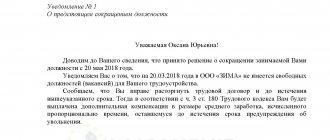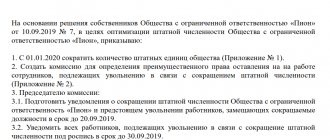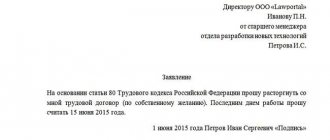General information
Reduction is the process of eliminating work positions, which is carried out taking into account compliance with the Labor Code. One option to reduce the number of staff is to eliminate positions. The staffing table is the main evidence that confirms the process of reducing the number of employees. If the company does not have this schedule, then a list of employees or payroll records may also be valid evidence.
Rightful dismissal
To date, legislation, taking into account Art. 179 of the Labor Code of the Russian Federation in the new edition with comments from 2021, indicates the procedure and reasons for dismissal. Thus, a manager can lay off his employees due to a reduction in the number of staff, completion of activities, or reorganization of the company.
The manager determines the required number of employees at the enterprise. Taking into account the legislation, the employer does not have to explain the decision to retrench, but formally the process itself must be carried out taking into account the Labor Code of the Russian Federation. It is possible to dismiss a person from an organization due to a decrease in the number of employees only during the liquidation of the position in which he is located.
Misconduct
In practice, illegal reductions that have no real justification are very often noted.
This process is illegal. Managers use it if they need to reduce their staff, but there is no underlying reason for this. If the process of terminating an employment contract is carried out incorrectly or if the procedure is not followed, these actions are also considered illegal. The rights of the redundant person in this case can be challenged in court. However, as practice has shown, it is very difficult to prove the illegality of a manager’s actions. Therefore, it is necessary to know who cannot be laid off when reducing staff according to the Labor Code of the Russian Federation.
Establishing assessment of skill levels
The degree of qualification of an enterprise’s employees is the criterion that is first taken into account during the selection of prospective candidates for the expected reduction. According to Part 1 of Article 179 of the Labor Code of the Russian Federation, those persons who have higher degrees of working qualifications, as well as the highest productivity indicators, are subject to retention in the workplace when the number of employees of the enterprise is reduced.
Knowledge level
According to Article 195.1 of the Labor Code of the Russian Federation, qualification levels are determined by establishing the level of knowledge, acquired skills and work experience that employees have. This assessment is made through a careful study of documentation, which contains information about the exact length of service of the working person, his professional and any other additional education, increased level of labor qualifications, possession of special scientific titles and academic degrees, and through an in-depth analysis of the results of the work performed worker
If two working persons have equal work experience and education category, then the lower level of qualifications of any of them will be indicated by the presence of any disciplinary penalties made for improper performance of their work duties or for complete refusal to perform them.
Any incentives that the head of the enterprise rewards his employees for quality work are also taken into account when assessing the qualifications of the company's employees, subject to the expected reduction in the number of workers.
Main stages
The reduction process has a number of main stages. The launch of the process itself must be confirmed by an appropriate order and the establishment of a staffing table. The schedule must be approved before starting the procedure itself. Those employees who do not have a position retained in the updated schedule are fired. Article 80 of the Labor Code specifies the further stages of this process:
- Two months before the date of termination of the agreement with employees, the employer must send a written notice to the trade union organization.
- Two months before the layoff, the employer must notify the local employment center in writing. The notice must indicate the specialty, position held, qualifications and profession of a particular employee. The employment center must be notified of the reduction at least three months in advance if this process is accompanied by large-scale layoffs.
- Two months before the due date, the employer is obliged to notify his employees of the upcoming dismissal against signature. If a person refuses to sign the notice, then the personnel department staff draws up a document that confirms this.
- The employer must offer employees an alternative - vacant positions in the same or another organization. If, during the warning, vacancies appear at the enterprise, then management is obliged to provide them to employees who have been laid off. If positions appear at the enterprise within a 2-month period, the employer notifies employees about this and does not have the right to hire new ones. When choosing vacancies, you need to take into account the health status and profession of the employee. If he agrees to the new position, the transfer process is carried out.
- The head of the organization can dismiss an employee without warning, by agreement of both parties, drawn up in writing. In this case, the former employee is additionally paid compensation, and its amount is not limited by law and will depend only on the agreement. The head of the organization signs a reduction order, which indicates the date and reasons for terminating the agreement.
- Retrenched workers must be fully paid off on the last day, and also issued with a work certificate. When dismissing citizens who are members of a trade union, the company's reasoned justification must be taken into account. Dismissal of persons under 18 years of age is possible with the consent of the state labor inspectorate.
The procedure for dismissing employees during layoffs
Labor legislation does not contain a ban on the dismissal of workers due to a reduction in the number of workers (staff) during the spread of coronavirus infection. In this case, a special procedure must be followed.
For your information
A reduction in the number of employees (staff) is one of the grounds for termination of an employment contract at the initiative of the employer (clause 2, part 1, article 81 of the Labor Code of the Russian Federation). When staffing is reduced, one or more positions are completely eliminated, and when the number of employees is reduced, the number of employees for a certain position is reduced.
The procedure for dismissing employees during layoffs involves the following steps.
| Employer's actions | Note |
| Issue a layoff order | The order is drawn up in any written form. It must reflect: – formulation of the reason for the reduction in the number of employees (staff); – positions subject to reduction; – persons responsible for delivering notices of layoffs and offering vacancies during the notice period, the timing of these activities; – other information necessary for the employer. |
| If legal proceedings arise, the employer must be prepared to justify the decision to lay off (Definition of the RF Armed Forces dated December 3, 2007 No. 19-B07-34) | |
| Determine categories of employees who cannot be laid off | It is impossible to reduce (part 6 of article 81, article 179, part 1, 4 of article 261, article 264 of the Labor Code of the Russian Federation, paragraphs 15, 28 of the Resolution of the Plenum of the Armed Forces of the Russian Federation dated January 28, 2014 No. 1): – pregnant women; – women with children under three years of age; – single mothers raising disabled children under the age of 18 or children under the age of 14; – persons raising children under 14 years of age without a mother (disabled children under 18 years of age); – the sole breadwinners of disabled children under the age of 18 or children under the age of three in a family with three or more young children, if the second parent (legal representative) does not work; – employees who cannot be dismissed based on the results of the assessment of preferential rights; – persons who are on sick leave or on vacation on the day of dismissal (the date of dismissal in this case must be postponed). Please note: the ban may be established by other federal laws. For example, on the basis of clause 19 of Art. 29 of Federal Law No. 67-FZ of June 12, 2002, it is impossible to lay off an employee who is a member of the election commission with the right to an advisory vote during the election campaign |
| Determine the categories of employees who have a preferential right to remain at work | The list of employees who have a preferential right to remain at work during layoffs is not provided for by law. To determine it, it is necessary to create a commission that will assess which of the employees has such a right. The criteria for assessing which employee to keep at work during layoffs are established in Art. 179 Labor Code of the Russian Federation. First of all, preferential rights are granted to employees with higher labor productivity and qualifications (Part 1 of Article 179 of the Labor Code of the Russian Federation). If labor productivity and qualifications are equal, the right to remain in work is given to: – family – if there are at least two dependents (Part 2 of Article 179 of the Labor Code of the Russian Federation); – the only breadwinners in the family (Part 2 of Article 179 of the Labor Code of the Russian Federation); – persons who received work injuries and occupational diseases during work (Part 2 of Article 179 of the Labor Code of the Russian Federation); – persons sent for advanced training without interruption from work (Part 2 of Article 179 of the Labor Code of the Russian Federation); – disabled people of the Second World War and combat operations to defend the Fatherland (Part 2 of Article 179 of the Labor Code of the Russian Federation); – employees who are granted a preferential right to remain at work by a collective agreement (if any) (Part 3 of Article 179 of the Labor Code of the Russian Federation). A preferential right may be granted by certain federal laws (for example, to persons who received or suffered radiation sickness and other diseases due to exposure to radiation due to the Chernobyl disaster, as well as to disabled people as a result of this disaster) (clause 1, 2, part 1, art. 13, clause 7, part 1, article 14 of the Law of the Russian Federation of May 15, 1991 No. 1244-1) |
| Notify laid-off employees | Employees must be notified of the upcoming layoff at least two months before dismissal (Part 2 of Article 180 of the Labor Code of the Russian Federation). Some employees have different notice periods: – no less than seven calendar days – for seasonal workers (Part 2 of Article 296 of the Labor Code of the Russian Federation); – no less than three calendar days – for employees who are hired for a period of up to two months (Part 2 of Article 292 of the Labor Code of the Russian Federation) |
| To issue a notice of the upcoming termination of an employment contract due to layoffs, a free form is used. The notification is drawn up in writing (Part 1 of Article 180 of the Labor Code of the Russian Federation) indicating the following basic information: – Full name and position of the employee to whom the notification is addressed; – reasons for dismissal; – details of the redundancy order; – proposals to the employee to submit documents confirming the presence of contraindications for certain jobs (to fulfill the requirement of Part 3 of Article 81 of the Labor Code of the Russian Federation when offering vacancies); – proposals to the employee to give consent to early termination of the employment contract (taking into account the established procedure). If, at the time of delivery of the notice, the employer has not assessed the priority right, the notice should include a request to provide documentation of the employee's benefits and advantages to remain at work (indicating the deadline for providing such information). To have an employee sign for familiarization, you can (Part 2 of Article 180 of the Labor Code of the Russian Federation): – or include a special column in the notification; - or draw up a notice in two copies, one of which is given to the employee, and the other will be kept by the employer (on the second copy the employee signs about receipt and familiarization with the document). If the employee refuses to sign the notice of layoff, it is necessary to draw up a corresponding act in the presence of at least two witnesses. Such an act will confirm that the employee has been informed of his dismissal. The notice is given personally to each employee. If this is not possible (the employee refuses to personally receive the notification or he works in a branch that is located in the same area as the parent organization, but far from its location), you can, in particular, send the notification by registered mail with a list of attachments and notification of delivery | |
| Notify the employment service | Notification of layoffs of employees is sent to the employment service authority in writing at least two months before dismissal. Information is provided about each employee being laid off. In particular, his position, profession, specialty and qualification requirements are indicated (paragraph 1, clause 2, article 25 of the RF Law of April 19, 1991 No. 1032-1 “On Employment of the Population in the Russian Federation” (hereinafter referred to as RF Law No. 1032-1 )). If a massive layoff is expected, the period within which the employment center must be notified is longer, and the form of notification differs from the form of notification in case of a regular reduction in the number of employees of the organization (staff). The specific form of notification is not established by law. At the same time, you should find out whether a special form has been established by the regional employment service authority (clause 1, clause 1, article 7.1-1 of the Law of the Russian Federation |
| No. 1032-1). If the form is established, the employment service authority has the right not to accept the employer’s notice drawn up in any form. As a result, the layoff period may be delayed. For information: in Letter No. TZ/5624-6-1 dated September 26, 2016, Rostrud recommended using the form of information about laid-off employees (given in Appendix 2 to the Decree of the Government of the Russian Federation dated February 5, 1993 No. 99), to which appropriate additions are made at the discretion of the employer , or a free written form that contains all the necessary information about employees | |
| Notify the union | The employer is obliged to notify the elected body of the primary trade union organization in writing about the reduction no later than two months before the start of the relevant activities, and if the decision to reduce the number of employees or staff may lead to mass layoffs of workers - no later than three months before the start of the relevant activities. The criteria for mass dismissal are determined in industry and (or) territorial agreements (Part 1 of Article 82 of the Labor Code of the Russian Federation). If you plan to dismiss employees who are members of a trade union, you must additionally take into account the reasoned opinion of the elected body of the primary trade union organization (Part 2 of Article 82 of the Labor Code of the Russian Federation). It is advisable to request a reasoned opinion one month before the planned dismissal of employees. This will allow you to comply with the rules of Part 5 of Art. 373 of the Labor Code of the Russian Federation (employees can be dismissed no later than one month from the date of receipt of a reasoned opinion from the trade union). If this deadline is missed, the dismissal may be considered unlawful (Appeal ruling of the Chelyabinsk Regional Court dated June 22, 2015 in case No. 11-6384/2015, Determination of the Moscow Regional Court dated January 31, 2012 in case No. 33-2507) |
| Enter information into the all-Russian vacancy database “Work in Russia” | In order to include information about a reduction in the number of employees (staff) and the possible termination of employment contracts in the all-Russian vacancy database “Work in Russia”, the employer must first register in this database (clause 2 of the Decree of the Government of the Russian Federation of April 12, 2020 No. 486). Information about the release of employees is posted in the personal account no later than the working day following the day the information included in such information was changed. In this case, it is necessary to comply with the list and formats of this information, approved by the Ministry of Labor and Rostrud, respectively (clause 3 of the Decree of the Government of the Russian Federation No. 486, clauses 1 - 5 of the Temporary Rules for the Submission of Information on Release, approved by this resolution) |
| Offer suitable vacancies to employees | Vacant positions offered to laid-off employees must comply with the requirements established by law (part 3 of article 81, part 1 of article 180 of the Labor Code of the Russian Federation, paragraph 1 of paragraph 29 of the Resolution of the Plenum of the Armed Forces of the Russian Federation of March 17, 2004 No. 2): – the employee will be able to perform work taking into account his state of health; – this can be either a vacant position or work corresponding to the employee’s qualifications, or a vacant lower position or lower paid job; |
| – vacancies must be in the given area. Vacancies in other localities are offered only if this is provided for by the collective agreement, agreements, or employment contract. Taking into account judicial practice, vacancies should be offered during the entire period of reduction measures (up to and including the day of dismissal), which will confirm the fulfillment of the requirements established in Part 3 of Art. 81 of the Labor Code of the Russian Federation requirements (Appeal ruling of the St. Petersburg City Court dated January 11, 2017 No. 33-1117/2017 in case No. 2-4529/2016). Labor legislation does not regulate the issue of offering temporary vacancies to employees. To avoid disputes with employees, such vacancies should be offered to him. Notification of vacant positions can be issued as a separate document or included in the text of the notice of upcoming layoffs | |
| In the form of notifying an employee about the availability of vacant positions (it is recommended to be in writing in order to fulfill the obligation provided for in Part 3 of Article 81, Part 1 of Article 180 of the Labor Code of the Russian Federation), the following information is indicated: – date of offer; – vacant position and structural unit. Since an employee may have several professions, the employer may request relevant information from him; – working hours for the proposed position; – amount of remuneration; – the deadline for making a decision and the official who will need to be informed about the decision made. The employee must sign a notice of the availability of vacant positions, which will confirm the employer’s compliance with the requirements of Part 3 of Art. 81 of the Labor Code of the Russian Federation (clause 31 of the Resolution of the Plenum of the Armed Forces of the Russian Federation No. 2). If an employee refuses to familiarize himself with the proposed vacancies against his signature, this must be recorded in the appropriate act. Such an act is drawn up in the presence of two witnesses (employees of the organization), who will put their signatures on it. If the employer does not have vacancies suitable for the employee or if there are vacant positions that the employee cannot occupy taking into account his qualifications or for health reasons, it is necessary to notify the employee about the absence of vacancies suitable for him, including for health reasons (compiled in a free form). Such notice may be issued as a separate document (notice) or as language in the notice of reduction. It is necessary to notify about the absence of vacancies on the day of notification of the layoff, as well as on the day of dismissal, since the courts check the legality of termination of an employment contract on the day of dismissal. The notification about the absence of vacancies must include a special column for the employee to sign the acquaintance. Or the notice is drawn up in two copies: one is given to the employee, and on the other, which will be kept by the employer, the employee signs for receipt and familiarization with the document. If the employee refuses to familiarize himself, a corresponding act is drawn up in the presence of witnesses from among the employees | |
| Prepare documents for dismissed employees | Required (Article 84.1 of the Labor Code of the Russian Federation): – issue an order (according to the unified form T-8, approved by Resolution of the State Statistics Committee of the Russian Federation dated January 5, 2004 No. 1, or a form approved by the employer). In the line “Grounds for termination (termination) of an employment contract (dismissal)” of the unified order form, you must reflect the basis for dismissal - clause 2 |
| Part 1 Art. 81 Labor Code of the Russian Federation. The wording will depend on how the employee is leaving (due to a reduction in the number of employees or staff). If a staff reduction has actually been made, and the order states that the employee was dismissed due to a reduction in the number of employees, he has the right to demand a change in the reason for dismissal, including through the court (Part 5 of Article 394 of the Labor Code of the Russian Federation); – make an entry in the work book (if it is maintained) or include information in information about work activities. The entry in the work book, depending on the event, is as follows: “Termination of an employment contract due to staff reduction, paragraph 2 of part one of Article 81 of the Labor Code of the Russian Federation” or “Termination of an employment contract due to a reduction in staff, paragraph 2 of part one of article 81 of the Labor Code of the Russian Federation" | |
| The employer must submit information about dismissal to the Pension Fund of the Russian Federation in the form SZV-TD (part 1, 2 of article 66.1 of the Labor Code of the Russian Federation, clause 1, 2.4 - 2.6 of article 11 of the Federal Law of 01.04.1996 No. 27-FZ “On individual (personalized) ) registration in the compulsory pension insurance system" (hereinafter referred to as Federal Law No. 27-FZ)). The SZV-TD form and the procedure for filling it out were approved by Resolution of the Pension Fund Board of December 25, 2019 No. 730p. Until December 31, 2020, there are special deadlines for submitting the SZV-TD form to the Pension Fund of Russia, which depend on when the employee was fired. If an employee is fired (clause 2 of article 2 of Federal Law No. 27-FZ, clauses “a”, “c” clause 1, clause 3 of the Government of the Russian Federation of 04/26/2020 No. 590): – in the period from April 1 to April 27, 2021 – information had to be submitted no later than April 28, 2020; – after 04/27/2020 – information is submitted no later than the working day following the day of issuance of the relevant order (instruction), other decisions or documents confirming the formalization of the employment relationship | |
| Pay employees the required amounts | When dismissed due to layoffs, employees are entitled to severance pay, average earnings for the duration of employment, as well as additional compensation (only if, at the employee’s request, he is dismissed early). Payments not directly related to layoffs are provided in accordance with the general procedure. In particular, upon dismissal, compensation must be paid for unused vacation upon dismissal. Severance pay for the first month after the dismissal of an employee is paid on the day of dismissal (part 4 of article 84.1, part 1 of article 140, part 1 of article 178, part 1 of article 318 of the Labor Code of the Russian Federation). It is necessary to pay the employee the average salary for the second and third months (the fourth, fifth and sixth months - for those who worked in the Far North or an equivalent area and leave their main place of work) if the employee submits the necessary supporting documents. Average earnings for the second month of unemployment are paid upon presentation by the employee of a work book (if maintained) and a passport (paragraph 1, clause 12 of the Regulations on the procedure for the release, employment of workers and employees and the provision of benefits and compensation to them, approved by the Resolution of the USSR State Labor Committee, the Secretariat of the All-Union Central Council of Trade Unions dated 03/02/1988 No. 113/6-64). Instead of a work book, an employee can provide information about his work activity (Article 66.1 of the Labor Code of the Russian Federation). |
| Payment of average earnings for the third month of unemployment is made when the employee submits a decision from the employment service body that he needs to retain such earnings for the third month (Part 2 of Article 178 of the Labor Code of the Russian Federation) | |
Employees not subject to layoffs
The legislation contains a list of those who cannot be laid off when reducing the number of employees according to the Labor Code of the Russian Federation of 2021. It is prohibited to dismiss the following list of persons:
- Women who are on parental leave.
- Women with children under three years of age.
- Citizens who are raising a minor child without a mother.
- Minors, without permission from the state labor inspectorate.
- Company employees who are on sick leave or on vacation.
Also, according to Art. 179 of the Labor Code of the Russian Federation with comments dated 2021 on dismissal, employees can go on parental leave until they reach the age of three years. The position and workplace must be retained.
Employees enjoying immunity upon dismissal
A number of workers have immunity from dismissal due to reduction, even with low labor productivity. Before you begin to compare the qualifications of employees and their labor productivity, you need to identify those employees who, by virtue of parts 1, 4 of Art. 261 of the Labor Code of the Russian Federation cannot be dismissed due to staff reduction. Pregnant women, single mothers with children under 14 years of age, or mothers from a complete family with a child under 3 years of age have immunity. Such employees should be immediately excluded from the list of persons subject to comparison and reduction.
If previously the question arose about which women are single mothers, this year the Supreme Court of the Russian Federation specified who falls into this category (paragraph 2, paragraph 28 of the Plenum Resolution No. 1 of January 28, 2014). These are women who are raising a child without a father due to his death, deprivation of parental rights, being in prison or evading raising a child.
And only after individuals whose dismissal is unacceptable can be identified, you can proceed to further steps: assessing the labor productivity and qualifications of the remaining employees.
Preemptive right
In addition to the list of those who cannot be laid off at work according to the Labor Code of the Russian Federation, the code also contains such a definition as “preemptive right.” Taking into account the law, it gives employees an advantage in maintaining their position during dismissal, taking into account social reasons or the quality of the duties performed. These employees can only be laid off as a last resort.
Citizens with an increased level of productivity and special qualifications have priority rights. You also need to take into account education and work experience. Qualification must be confirmed by documentation of completion of studies, transcripts of rank assignment, and certificates of advanced training. To assess qualifications, the manager has the right to conduct certification.
The following persons also have a priority right:
- Self-supporting family (no other source of income).
- Supporting dependents.
- Improved qualifications as appointed by the manager.
- Disabled people of any category.
- Injured during work.
The collective agreement may also indicate other groups of workers who have preferential rights.
Taking into account the level of knowledge when reducing
The employer can determine the level of education of the employee and his qualifications from the documents listed in Art. 60 Federal Law dated December 29, 2012 No. 273FZ. The employee had to present a diploma, certificate, certificate or certificate when applying for a job. But if he brought the documents already during the measures to identify the preemptive right, then they still need to be accepted. A refusal will play into the hands of the employee, who, in the event of a dispute, will have to prove that the employer did not conduct a comprehensive analysis of his professional qualities. Having a second education or a higher qualification category makes it possible to keep the employee at work. Otherwise, the employer has the right to conclude that there is no preemptive right.
At the same time, the presence of several higher or secondary vocational education is not always a determining factor. If education is not required to occupy a specific position, then the employee will not have advantages over other employees.
Payments and compensations
According to Art. 141 of the Labor Code, during the termination of employment agreements with employees, the head of the company is obliged to make a full settlement with them and pay all compensation.
If a person is fired due to reduction, then he must certainly receive severance pay in an amount equal to the average salary. For 2 months, an allowance is also paid while searching for a new job. This payment can also be made in the third month if the laid-off employee contacted the employment center within 2 weeks after termination of the employment agreement and did not find a suitable position.
Additional payments are paid to citizens who were laid off without warning and upon agreement with management. The amount of compensation is determined by average earnings, which is calculated in proportion to the time remaining until the end of the notice period for dismissal. Pensioners are paid any compensation, just like full-time employees. The chief accountant and management of the company are paid payments in the amount of at least 3 average salaries per month.
Employees who quit due to a reduction in the number of jobs in the organization are entitled to compensation for days worked in that month and payments for unused vacation.
The amount of severance pay can be disputed. In this case, the company pays the person the undisputed portion of the total amount. The remaining amount is paid taking into account the court decision or by agreement between the manager and the employee.
Helpful hints when making comparisons
The legislation does not contain specific and clear instructions that affect the procedure for establishing the privileges of employees to remain at work in the event of reductions in the number of employees of the enterprise.
The courts have confidence in such a procedure, which was carried out by commission and with the subsequent consolidation of the results obtained directly in writing.
Key points when carrying out this procedure:
Special Commission
- The composition of the commission must include the heads of precisely those departments in which reductions are expected to be made. There should also be people present who represent trade unions and other structural units, for example, personnel, legal, and performing quality control.
- The creation of this commission should be formalized by orders for the enterprise, which will determine the competence of each individual member, that is, the heads of departments are responsible for reporting on the work performed, the characteristics of workers, and employees of the personnel department, for example, provide information on incentives and penalties.
- It is effective to compile tables that compare job performance and qualifications according to several criteria.
- The results obtained from listening to commission meetings must be recorded.
- The conclusions of this commission should be based on an assessment of the level of performance of each individual employee based on the sum of the criteria. The court does not recognize dismissals as legitimate if the higher qualification level of one worker was established based on the shorter work experience of any other worker.
- If those working persons of the organization who are supposed to be laid off are registered as active members of trade unions, then the opinions of its members must be taken into account.
Determining the preferential rights of employees is the most important procedure during a period of reduction in the number of company employees. This activity must fully comply with all norms of adopted labor legislation. Any employer will carry out such a procedure very carefully and reflect the results and all the results of each individual stage in the documentation if it is interested in reducing the risks of recognizing the dismissals of its employees as illegal.
Top
Write your question in the form below
Alternative methods
An alternative to reduction is termination of the agreement by agreement of the two parties . This is beneficial for the manager, since the employer is exempt from paying severance pay and additional payments, the opportunity to exercise his right to appeal the decision of the employee’s management in court is reduced, and notification of the employment center and the trade union is not required. The list of persons who cannot be fired during layoffs does not apply to this procedure.
Often management forces employees to leave voluntarily. Thus, the employee loses all compensation that he is entitled to during dismissal.
THEY DO NOT NOTIFY THE EMPLOYMENT SERVICE AND THE TRADE UNION
In accordance with paragraph 2 of Art. 25 of the Law of the Russian Federation dated April 19, 1991 No. 1032 - 1 “On employment in the Russian Federation” (as amended on July 29, 2017, hereinafter referred to as Law No. 1032-1) on reducing the number or staff, even if only one position or one employee, you must notify the employment service no later than two months in advance. If the reduction is massive, three months before the start of the reduction. Each region has its own notification form. It should be clarified on the websites of regional employment services. Let's give an example of a notification in Moscow (Example 5).
The mass scale criterion is determined by sectoral, territorial or regional agreements between trade unions and employers (part one of Article 82 of the Labor Code of the Russian Federation).
If these agreements are not applicable to a specific employer, you must be guided by clause 1 of the Regulations on the organization of work to promote employment in conditions of mass layoffs (approved by Government Decree No. 99 dated 02/05/1993).
According to part one of Art. 82 of the Labor Code of the Russian Federation, if the organization has a trade union, it must be notified within the same time frame (Example 6).
Employee actions
After dismissal, you can contact a number of authorities . First, you can send a written notice to the company's union. The union must respond to the complaint within 7 days. An incident of wrongful dismissal may be considered by the prosecutor's office and the labor inspectorate. If the labor inspectorate and the trade union do not determine violations of the dismissal, you can file a lawsuit. This can be done within three months from the time the person learned of the violation of rights.
If a redundant employee wants to challenge the termination of the agreement, then the claim must be filed within one month from the date of issue of the employment document or a photocopy of this document. Illegally terminated employees are not paid fees and other costs during legal proceedings.
If the dismissal is declared illegal, the person is reinstated in his position by the body that was authorized to consider this case. The employee is compensated for the average monthly salary for the entire period of absenteeism or the difference for the time he performed low-paid work, as well as compensation for causing moral damage.
Dismissal during a reduction in workforce at an enterprise can affect any person. Therefore, it is necessary to know the list of people who cannot be fired. These issues are fully regulated by the Labor Code of the Russian Federation.
The manager’s decision to dismiss due to layoffs can be challenged both in court and when contacting the Federal Labor Inspectorate, the prosecutor’s office, or a trade union organization. The Labor Code of the Russian Federation regulates the rights of a redundant person. When difficulties arise, you should seek help from an experienced lawyer.
Preferential right to remain at work in case of staff reduction
The guarantees established by law for laid-off workers also include a preferential right to remain at work during layoffs. This right is that the employer will have to leave at the enterprise the employee whose qualifications are higher and whose quality of work is better than that of others.
If there are several such employees, then, according to the law, the following categories have the right to retain their positions:
- - workers who support two or more disabled family members;
- - workers whose earnings are the only source of income for the whole family;
- - employees who were injured or have an occupational disease while working at this enterprise;
- — disabled people of the Great Patriotic War and disabled people who took part in hostilities to defend the state;
- - employees who improve their qualifications at the place of work in the direction of the employer.
A collective agreement drawn up at an enterprise or organization may indicate an expanded list of categories of workers who have a preferential right to remain at work in the event of staff reductions.
In addition, the Labor Code of the Russian Federation protects from layoffs pregnant women, mothers raising children under three years of age, single mothers raising children under fourteen years of age, or a disabled child under eighteen years of age, as well as those who The following categories of children are being raised.
Employees who are on vacation or sick leave due to temporary disability at the time of layoff cannot be dismissed In case of violation of this norm, the employee has the right to appeal the dismissal in court and be reinstated in his previous position.
This must be done within one month from the day the employee received a copy of the dismissal order or from the moment the work book was issued. Otherwise, you will have to restore the missed deadline in court. According to the Civil Procedure Code, the prosecutor must make his conclusion on issues of reinstatement, and he can also appeal the court’s decision.
How to open an individual entrepreneur for two? Is this even possible? If not, what are your options?
You can find out what you need to restore your passport in this article.
How to evaluate employee qualifications
By virtue of Part 1 of Art. 195.1 of the Labor Code of the Russian Federation, when comparing the qualifications of workers, the employer assesses the level of knowledge, skills, professional skills, and work experience.
“ConsultantPlus” has many ready-made solutions, including how to fire employees to reduce the number of employees.
When eliminating several identical positions, the employer has the right to create a commission to which he can delegate the authority to determine the preferential right to remain at work. The work of the commission must be carried out on the basis of the relevant regulations.
Thus, the commission is authorized:
- evaluate the business qualities and qualifications of employees;
- compare labor productivity;
- establish categories of persons who are not subject to reduction by force of law (pregnant women, single mothers, etc.).
During the assessment process, any written or oral evidence may be used to confirm work performance and professional qualities. These may be documents on additional education, advanced training courses, certificates, gratitude and encouragement. Some enterprises keep logs of violations of labor discipline, information from which can also be used by the commission. As a result, preference should be given to employees who objectively have the highest professional level.
Subscribe to our newsletter
Yandex.Zen VKontakte Telegram








